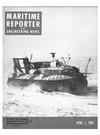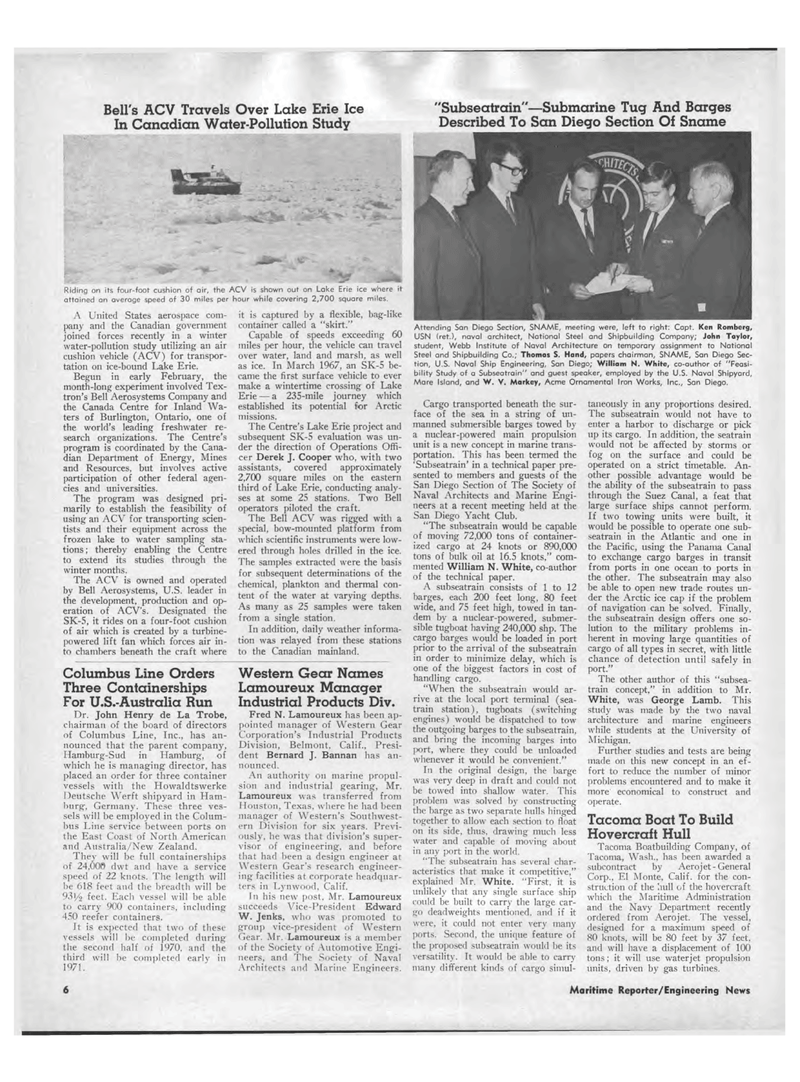
Page 4: of Maritime Reporter Magazine (April 1969)
Read this page in Pdf, Flash or Html5 edition of April 1969 Maritime Reporter Magazine
Bell's ACV Travels Over Lake Erie Ice "Subseatrain"?Submarine Tug And Barges In Canadian Water-Pollution Study Described To San Diego Section Of Sname Riding on its four-foot cushion of air, the ACV is shown out on Lake Erie ice where it attained an average speed of 30 miles per hour while covering 2,700 square miles. Attending San Diego Section, SNAME, meeting were, left to right: Capt. Ken Romberg, USN (ret.), naval architect, National Steel and Shipbuilding Company; John Taylor, student, Webb Institute of Naval Architecture on temporary assignment to National Steel and Shipbuilding Co.; Thomas S. Hand, papers chairman, SNAME, San Diego Sec-tion, U.S. Naval Ship Engineering, San Diego; William N. White, co-author of "Feasi-bility Study of a Subseatrain" and guest speaker, employed by the U.S. Naval Shipyard, Mare Island, and W, V. Markey, Acme Ornamental Iron Works, Inc., San Diego. A United States aerospace com-pany and the Canadian government joined forces recently in a winter water-pollution study utilizing an air cushion vehicle (ACV) for transpor-tation on ice-bound Lake Erie. Begun in early February, the month-long experiment involved Tex-tron's Bell Aerosystems Company and the Canada Centre for Inland Wa-ters of Burlington, Ontario, one of the world's leading freshwater re-search organizations. The Centre's program is coordinated by the Cana-dian Department of Energy, Mines and Resources, but involves active participation of other federal agen-cies and universities. The program was designed pri-marily to establish the feasibility of using an ACV for transporting scien-tists and their equipment across the frozen lake to water sampling sta-tions ; thereby enabling the Centre to extend its studies through the winter months. The ACV is owned and operated by Bell Aerosystems, U.S. leader in the development, production and op-eration of ACV's. Designated the SK-5, it rides on a four-foot cushion of air which is created by a turbine-powered lift fan which forces air in-to chambers beneath the craft where Columbus Line Orders Three Containerships For U.S.-Australia Run Dr. John Henry de La Trobe, chairman of the board of directors of Columbus Line, Inc., has an-nounced that the parent company, Hamburg-Sud in Hamburg, of which he is managing director, has placed an order for three container vessels with the Howaldtswerke Deutsche Werft shipyard in Ham-burg, Germany. These three ves-sels will be employed in the Colum-bus Line service between ports on the East Coast of North American and Australia/New Zealand. They will be full containerships of 24,000 dwt and have a service speed of 22 knots. The length will be 618 feet and the breadth will be 931/9 feet. Each vessel will be able to carry 900 containers, including 450 reefer containers. It is expected that two of these vessels will be completed during the second half of 1970, and the third will be completed earlv in 1971. it is captured by a flexible, bag-like container called a "skirt." Capable of speeds exceeding 60 miles per hour, the vehicle can travel over water, land and marsh, as well as ice. In March 1967, an SK-5 be-came the first surface vehicle to ever make a wintertime crossing of Lake Erie ? a 235-mile journey which established its potential for Arctic missions. The Centre's Lake Erie project and subsequent SK-5 evaluation was un-der the direction of Operations Offi-cer Derek J. Cooper who, with two assistants, covered approximately 2,700 square miles on the eastern third of Lake Erie, conducting analy-ses at some 25 stations. Two Bell operators piloted the craft. The Bell ACV was rigged with a special, bow-mounted platform from which scientific instruments were low-ered through holes drilled in the ice. The samples extracted were the basis for subsequent determinations of the chemical, plankton and thermal con-tent of the water at varying depths. As many as 25 samples were taken from a single station. In addition, daily weather informa-tion was relayed from these stations to the Canadian mainland. Western Gear Names Lamoureux Manager Industrial Products Div. Fred N. Lamoureux has been ap-pointed manager of Western Gear Corporation's Industrial Products Division, Belmont, Calif., Presi-dent Bernard J. Bannan has an-nounced. An authority on marine propul-sion and industrial gearing, Mr. Lamoureux was transferred from Houston, Texas, where he had been manager of Western's Southwest-ern Division for six years. Previ-ously, he was that division's super-visor of engineering, and before that had been a design engineer at Western Gear's research engineer-ing facilities at corporate headquar-ters in Lynwood, Calif. In his new post. Mr. Lamoureux succeeds Vice-President Edward W. Jenks, who was promoted to group vice-president of Western Gear. Mr. Lamoureux is a member of the Society of Automotive Engi-neers, and The Society of Naval Architects and Marine Engineers. Cargo transported beneath the sur-face of the sea in a string of un-manned submersible barges towed by a nuclear-powered main propulsion unit is a new concept in marine trans-portation. This has been termed the 'Subseatrain' in a technical paper pre-sented to members and guests of the San Diego Section of The Society of Naval Architects and Marine Engi-neers at a recent meeting held at the San Diego Yacht Club. "The subseatrain would be capable of moving 72,000 tons of container-ized cargo at 24 knots or 890,000 tons of bulk oil at 16.5 knots," com-mented William N. White, co-author of the technical paper. A subseatrain consists of 1 to 12 barges, each 200 feet long, 80 feet wide, and 75 feet high, towed in tan-dem by a nuclear-powered, submer-sible tugboat having 240,000 shp. The cargo barges would be loaded in port prior to the arrival of the subseatrain in order to minimize delay, which is one of the biggest factors in cost of handling cargo. "When the subseatrain would ar-rive at the local port terminal (sea-train station), tugboats (switching engines) would be dispatched to tow the outgoing barges to the subseatrain, and bring the incoming barges into port, where they could be unloaded whenever it would be convenient." Tn the original design, the barge was very deep in draft and could not be towed into shallow water. This problem was solved by constructing the barge as two separate hulls hinged together to allow each section to float on its side, thus, drawing much less water and capable of moving about in any port in the world. "The subseatrain has several char-acteristics that make it competitive," explained Mr. White. "First, it is unlikely that any single surface ship could be built to carry the large car-go deadweights mentioned, and if it were, it could not enter very many ports. Second, the unique feature of the proposed subseatrain would be its versatility. It would be able to carry many different kinds of cargo simul-taneously in any proportions desired. The subseatrain would not have to enter a harbor to discharge or pick up its cargo. In addition, the seatrain would not be affected by storms or fog on the surface and could be operated on a strict timetable. An-other possible advantage would be the ability of the subseatrain to pass through the Suez Canal, a feat that large surface ships cannot perform. If two towing units were built, it would be possible to operate one sub-seatrain in the Atlantic and one in the Pacific, using the Panama Canal to exchange cargo barges in transit from ports in one ocean to ports in the other. The subseatrain may also be able to open new trade routes un-der the Arctic ice cap if the problem of navigation can be solved. Finally, the subseatrain design offers one so-lution to the military problems in-herent in moving large quantities of cargo of all types in secret, with little chance of detection until safely in port." The other author of this "subsea-train concept," in addition to Mr. White, was George Lamb. This study was made by the two naval architecture and marine engineers while students at the University of Michigan. Further studies and tests are being made on this new concept in an ef-fort to reduce the number of minor problems encountered and to make it more economical to construct and operate. Tacoma Boat To Build Hovercraft Hull Tacoma Boatbuilding Company, of Tacoma, Wash., has been awarded a subcontract by Aerojet-General Corp., El Monte, Calif, for the con-struction of the hull of the hovercraft which the Maritime Administration and the Navy Department recently ordered from Aerojet. The vessel, designed for a maximum speed of 80 knots, will be 80 feet by 37 feet, and will have a displacement of 100 tons; it will use waterjet propulsion units, driven by gas turbines. 6 Maritime Reporter/Engineering News

 3
3

 5
5
